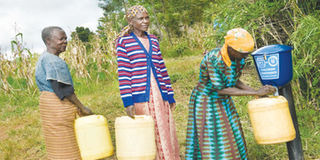Towards safer drinking water

Elderly women fetching water. Photo/FILE
What you need to know:
- About 1.9 million children die every year from water-borne diseases such as diarrhoea and cholera, and unsafe water is usually the cause.
Some months ago, Janerose Papai would make a two-kilometre walk to the nearest shallow well, five times a day, to fetch water for her family’s use.
The nearest medical centre to her home in Magola Village, Teso South District was about four kilometres away.
Frequently, she and her family would make the four-kilometre walk to seek treatment for water-borne diseases they would contract from using the well’s water. But since she began to treat her water, all that is in the past. Unlike many households in urban areas, the people of Magola do not have access to piped water, which is treated at water plants.
Today, Janerose treats her water as soon as she collects it from the shallow well by using the recommended dose from the chlorine dispenser set up next to the well. By the time she gets home, the water is safe to drink.
“My children contracted cholera and could not attend school for some time. At first we would tell the difference in taste of the water but now I cannot drink water that has not been treated,” she said.
The housewife is among 600,000 people in Busia, Nambale, Mumias, Bungoma, Kakamega, Vihiga, Siaya, Kitui and Machakos who use the dispenser, which is made up of a small tank which stands on a plastic pipe, erected close to water collection points.
“The tank has a valve that is well calibrated to release a dose of 3ml. So every time they make a turn of the tap, it releases a dose for a 20-litre container,” Dispensers for Safe Water Busia Area Coordinator John Ikoluot said, adding, “Before we introduce the tank, we have a community meeting educating the people on the health benefits of using treated water.”
During such meetings, the villagers choose a ‘promoter’ among them whose job will be to refill the tank and pass on the word about the system.
“About 85 per cent of the water around here is contaminated by chemicals through the use of fertilisers, faecal matter from animals grazing near water sources and open defecation,” Mr Ikoluot said.
Mr Ikoluot explained that the dispenser works in tandem with a community education programme.
“They are informed about the dangers of unsafe water and how to use the dispenser. A local volunteer works to continually educate the community about the benefits of the dispenser, to promote its use, and maintain the supply of chlorine,” he said.
About 1.9 million children die every year from water-borne diseases such as diarrhoea and cholera, and unsafe water is usually the cause.
DSW Director of Programmes Eric Kouskalis said the research leading to the development of the project “found that water at the collection points was less contaminated than that in the homes, and one of the hypotheses for that was re-contamination during transport and storage”.
“So the research turned to looking at ways of making sure it was safe at the point of consumption,” he said.
The organisation provides the dispensers at no cost to the communities and is looking at ways to ensuring financial sustainability through public funding.
In Busia so far, there are 405 dispensers, some put up at health centres, schools and protected springs.
The system was first developed in 2007 by Innovations for Poverty Action in Busia County, which hosts the DSW initiative, and implemented in collaboration with the Ministry of Public Health and Sanitation.
Recently, Dispensers for Safe Water received an international award — the Stone Prize for Innovation and Entrepreneurship — which recognised its efforts to increase access to safe drinking water.
The competition involved over 170 water initiatives from 37 countries and included a review by an international panel of water experts.
Busia District Health Officer Mr Ambrose Fwamba said that, in a county whose latrine coverage was pegged at 74.5 per cent — with rampant open defecation — there were low chances of reducing water contamination, particularly at the popular shallow wells.
“The water they were drinking was contaminated and the intervention initially could have been to have everybody use a pit latrine and they complement with water treatment mechanisms,” he said. “This water issue is one of behaviour change and, depending on the motivation, it may take long to catch on.”




